As lure anglers, we naturally challenge ourselves when it comes to catching fish, and in some ways we’re deliberately handicapping ourselves to better the challenge. It’s like choosing a pocketknife for a dual. So it makes sense that for lure anglers wanting a challenge, there is nothing better than fly fishing.
In Australia, there isn’t a whole lot of fly fishers and the reasons are various, but very often I hear things like, “It’s too expensive,” or, “It’s too much trouble to learn,” or even, “It’s just not as effective as conventional fishing”. Over time, fly fishers have systematically proven these conceptions wrong, and if you just invest some effort, there’s no reason why you can’t either.
Granted, making the switch over to fly tackle isn’t always going to be easy, but there’s no reason why you should wind up with an empty pocket and a long wand you never use.
Fly fishing unlocks many fishing opportunities and has over the years opened the jaws of species we previously thought were uncatchable! For a lot of anglers, it refreshes their interest in what they may have found boring with conventional tackle. But for most, they just enjoy the challenge of presenting the fly to the fish and fighting them on a big silly stick!
You don’t have to make a complete ‘switch’ either. My friends and colleagues who fish fly still love fishing with conventional gear in conjunction with fly – I don’t mind it either!
Making the switch has only a few cons, but the main one is you may become insatiably addicted.
Okay, maybe fly fishing equipment is on average a tad more expensive… but if you’re going to make the switch, my recommendation is to start small, in both price and tackle weight.
There are plenty of ‘starter packs’ with all the necessary gear to start off fishing for light tackle sportfish, but most of us like to tailor our rig to our needs. This means buying the individual parts to make up your first fly set up, and this doesn’t have to burn a hole in your wallet.
If you’re interested in saving money, second-hand gear may be worth a look – some of my best fly rod memories came from second hand fly gear. But, there exists fly equipment that retails for a similar price to most affordable conventional gear ($100-150 range), you just need to have a good look around until you find what you’re after.
The gear you buy should be dictated by the species you plan to target once you get off the mark. As a result of the gear being slightly more expensive, most fly fishers have rods they use for multiple applications, so versatility is something to keep in mind.
For most bread and butter fish, a 5-8wt rod is perfect. If, for example, you live down south where you may find trout, bass, bream and flathead, a 5wt is a great all-rounder. However, if you live up in the tropics where everything pulls a bit harder, an 8wt is fantastic for species such as small trevally, barramundi, sooty grunter, mangrove jack, tarpon and queenfish.
As smaller fish are generally fought by hand (with the exception of some pelagics), your reel will serve the purpose of just holding the fly line – no large arbors or waterproof drags needed. Anything that can hold 50-100m of 20-30lb braid as backing and a fly line will be perfect. Small reels like this can be found for under $100 retail, and when paired with a rod of around the same price, you’ve got yourself a pretty deadly little combo.
As far as lines go, these depend very much on what you intend on targeting. As a guide, any surface work should be carried out with floating line, anything just under the surface or in the top 2-4m of the water column will be easily handled with an intermediate line. For any deeper applications, such as schooled fish in deep water or fast flowing situations, a fast-sinking should be used.
When you’re setting the gear up, there’s many different methods you can use. When I was getting started, I did a lot of research. I watched lots of videos, talked to a lot of people and read a lot of fly fishing magazines just to gain some perspective.
If you want to get into tying your own flies, the internet is a fantastic place to start (and stay once you’ve learned the basics!) If you think you’ll be a ‘buyer’ not a ‘tier’, there are plenty of professional tiers for your benefit!
Once you’ve got yourself a rig and started treating it like a newborn, you’ll be wanting to know how to use the thing! Learning to cast a fly is like learning anything – you need to practise.
To start with, you should just grip the rod (without any line out) and make some air casts by swinging your dominant arm and shoulder forwards to about 10 o’clock, and back to about 1 o’clock (making sure there is a snap with the wrist on the forward stroke, like you would with a conventional rod.)
Online tutorials are a great way to see what it should look like, but most anglers reading this will have seen at least someone doing it – you probably wouldn’t be reading it otherwise!
Once you feel comfortable, find an empty space such as a park, street or the back yard (if it’s big enough) and put the rod and reel down. Pull some line out the end of the guides, about 4-5m should be enough. Then, practise lifting that line with a cast and laying it back down again.
As you gradually increase the amount of line out the end of the guides, you can tie some cotton wool to the end to act as a mock fly, or even a fly itself, and get used to the added weight of the fly.
When you feel you’re ready, it’s time to hit the water!
What you chase with the long wand will depend on where your favourite haunts are, but it’s logical to target species you’d usually target on conventional gear.
Almost everything you can target on conventional gear can be targeted on fly tackle, that’s the beauty of fly fishing! For some species, you need to get a bit creative, but countless pioneers of the sport have broken barriers and opened up fisheries for us fluff chuckers.
As mentioned before, starting small is a good idea, and this goes for target species as well. Fighting bigger fish on fly tackle takes a bit of practise and can result in broken equipment if done carelessly, but will be covered in upcoming issues.
A great way to get started is to try fly fishing for a species you’re confident in fishing for with conventional tackle in a place you’ve already sussed out. You’ll be surprised how similar the tactics can be.
The differences are that you mightn’t be able to make a cast as far as you would with your spin rod or baitcaster, you also might be restricted in your back cast. There are advantages though. A fly is often much more natural looking and in many instances is a better representation of the aquatic food source you’re trying to imitate. There have been many occasions where I’ve witnessed fly out fish conventional tackle 10 to 1, and it’s no accident! You may be surprised how many fish you start fooling on well-presented flies.
Obviously, to begin with you should try and match your fly to the lures or soft plastics you’ve been having success on, but the real fun starts with experimentation. You may even find a technique that works better than your standard means of fishing!
The list of light tackle sportfish catchable on fly is constantly is very long and constantly growing. With that in mind, there’s a few tried and true species that are great for learning to swing flies.
In southern estuaries, bream, whiting, silver trevally, Australian salmon and flathead are very suitable targets if that’s what you’re already used to, and the beauty of fish like this is they are easily accessed on foot or by boat.
Up north, aggressive species such as sooty grunter, various trevallies, tarpon, queenfish, small mackerel, steelback salmon, barramundi and pikey bream will all take flies. With so many species up this way though, there’s always going to be other obscure and wonderful targets to tangle with – you just have to think outside the box. Where there’s a chance of encountering larger by-catch, a heavier rig might be a sensible investment. As mentioned, if I was fly fishing for the common species up north, I’d opt for a sturdy 8wt with 100-150m of back just to be safe.
Down in our southern freshwaters, where trout and bass make up a large portion of the fishy population, a nice light rig would be the order of the day.
A lot of it will come down to common sense, and further research into the your chosen area will help you to pick the type of tackle you need for your target species.
Obviously, there’s too many species out there to cover in just one article, but I believe for every lure, there’s a fly to match or better it! Get out there and start swinging!
Getting started: Things you need
Rod
Reel
Backing braid
Fly Line
Leader material (fluorocarbon or monofilament)
Assortment of flies
Optional items
Fly box with foam slots
Line grease
Leader connectors (loops can also be tied with fly line)
Forceps
12 TOP FLIES:
Clouser MinnowExcellent all-rounder; synonymous with flathead.
Gurgler:Perfect for imitating bugs; great for bass, sooty grunter, jungle perch and more.
Dahlberg Diver: A classic surface pattern, perfect for bass, barra, saratoga and more.
Bass Vampire:Great for deeper work for bass and other smaller predators.
Bendback Style Fly:Excellent natural sub-surface pattern ideally worked just below the surface.
Bread Pattern:Can be made from different white materials; made to imitate bread in berley trails for bream, mullet, milkfish and more.
Surf Candy:One of the best generic baitfish imitations; great for trevally, queenfish, tarpon, mackerel, tuna, kingfish and more in smaller sizes.
Crease Fly:One of the simplest saltwater popper patterns; great for same species.
Gold Bomber Fly:Made to imitate the famous Gold Bomber lure; hugely successful on barramundi and other larger northern predators.
Red Tag:Famous dry fly for trout; perfect for exploratory trips for stream trout.
Woolly Bugger:Large nymph-style fly; great for trout in streams and lakes, and for other predatory freshwater species like bass, sooty grunter, jungle perch and more.
Black Pheasant-Tail Nymph:Small generic nymph; excellent for trout, and successful on carp.
Reads: 2161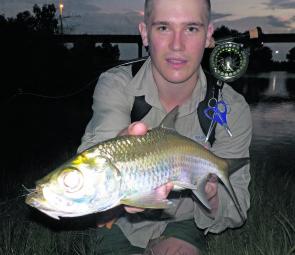
Tarpon are a great light-tackle fly target – especially for those who live up north.
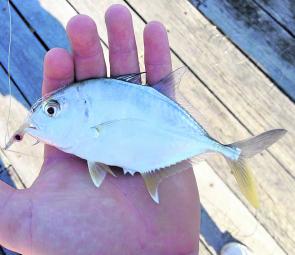
Starting small is the key to gaining an understanding of fly fishing, even if they are absolute tiddlers like this mini GT!
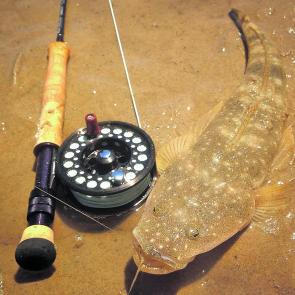
Flathead are the perfect introduction to saltwater fly fishing. Half a dozen Clouser Minnows and a nice light rig is all you need for hours flats fishing fun!
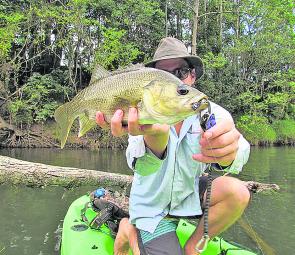
Fly fishing from a kayak is very productive, especially on river bass. This Northern NSW beast took Tom’s Bass Vampire fished under the snag behind him.

For those who aren’t familiar with sooty grunter, they will eat anything… and that includes flies!
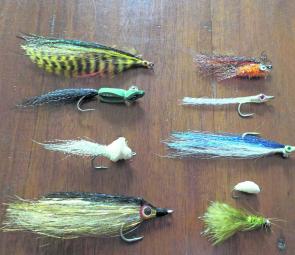
If the author was to do a trip up and down the coast with a small outfit, these are the flies he would take. Clockwise from top left: Bendback Fly, Grabham’s Gurgler (with eyes), Dahlberg Diver, Gold Bomber Fly, Olive Woolly Bugger, Deer Hair Bread Patter

Chaos ensues as Tom battles a North Queensland sooty grunter in the fast water!




